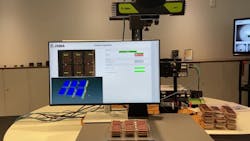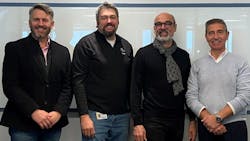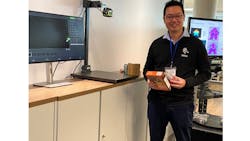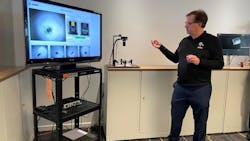Zebra Technologies Integrates Acquisitions into Machine Vision Product Line
Zebra Technologies’ purchase of Matrox Imaging was one of the biggest news stories of 2022 for the machine vision industry. Since then, the automation company has integrated frame grabbers, smart cameras, vision controllers, software, and other products from Matrox into Zebra’s machine vision product line.
Founded in 1969, Zebra (Lincolnshire, IL, USA) is best known for barcode label printing and mobile scanning. It entered the machine vision market initially by launching smart cameras and industrial scanners in 2021.
Related: Zebra Technologies Releases Smart Camera and Industrial Scanner Product Lines
It has added to those initial products with strategic investments in the machine vision industry. In addition to Matrox (Montreal, Quebec, Canada), Zebra in 2021 acquired both Adaptive Vision (Gliwice, Poland), which was known for its graphical machine vision software library, and Fetch Robotics (San Jose, CA, USA), which sold autonomous mobile robots.
Most recently in December 2024, Zebra announced its intention to acquire Photoneo (Bratislava, Slovakia), a developer of 3D imaging solutions.
Zebra has been investing in its acquisitions. For example, the company has been adding staff and other resources to the former Matrox Imaging operation in Montreal.
The company focuses its technology development efforts on addressing three broad categories of industrial processes:
- Asset visibility, which involves digitizing the track and trace process, such as through a barcode label.
- Connected frontline worker, which involves using handheld devices or wearables to help employees maximize efficiency and productivity.
- Intelligent automation, which involves creating automated tasks and solutions.
Related: Zebra Technologies to Acquire Photoneo
In December, Zebra held a press event and ribbon cutting to bring attention to its machine vision achievements as well as unveil new office and development space in Montreal. Vision Systems Design Editor in Chief Linda Wilson attended the event. She sat down with executives from Zebra Technologies for a round-table discussion on trends in machine vision. Rehana Begg, Editor in Chief of Machine Design, a VSD partner brand, also attended the event.
Earlier in the day, Joe White, chief product and solutions officer at Zebra, spoke with Wilson and Begg.
We've included excepts from those conversations in this article.
Major Automation Technology Trends in 2025
Joe White, chief product and solutions officer: As we look into 2025, automation will continue to accelerate and be a theme for our customers. I mean that in the broadest sense—not just robots but automating workflows. AI will get grounded in reality. Not the hype that I think we have all experienced over the last 24 months. AI will get grounded in useful use cases from an automation of intelligence perspective as well as from an operational efficiency and driving productivity gains in work that we do. I think the hype cycle is coming to an end, if you will. I think most people now know the limitations of it.
Zebra’s Strategy for Automating Workflows
Andy Zosel, senior vice president: We have enabled our customers to take their processes and workflows and transition them from pen and paper to digital workflows through barcode, RFID and other technologies. Throughout our history, we have done significant investments like creating mobile devices—we call them mobile computers—that have that scanning and digitization capability built in. And that has created new ways of working across many industries. We service everything from retail, transportation and logistics, manufacturing, and healthcare—across the board. We had a strong right to play from a fixed industrial scanner perspective, so we started investing from that base. A clear adjacency to that space would be machine vision. The whole premise of Zebra is the bulk of our business—whether it is labeling and printing or giving products a digital voice or the scanning and mobile computing and translating the physical world into the digital world—is that transition from manual to digital. A big part of our intelligent automation and our biggest investment so far has been in machine vision and intelligent automation scanning.
Donato Montanari, vice president, general manager, machine vision: Why this drive for automation? The fact is if you look at next year worldwide, the shortage of workers is 46 million. That translates into an unrealized economic output of roughly $3.8 trillion. And that is why we see such a need from our customers. They want to talk about fixed industrial scanning, they want to talk about machine vision, they want to talk about robotics. That is their only way to stay in business.
Jim Witherspoon, principal, systems engineering: They don't want to go learn each application. They want these more trained things. The OCR tool that you just drop in. Our end users need engineers, too. They don’t have enough. You go to some of the plants, and they are working day and night, and they don’t have time to come up with a new machine vision solution. They are looking for us to bundle this stuff and create a solution.
Related: Zebra Technologies to Acquire Matrox Imaging
The Important Engineering Skill Sets for Process Automation
Montanari: If you look at the skill set, it is really engineering and software development. These are the main roles, even on the sales side. This is technical sales; it is B2B. In general, if you look at the automation process, it is legs, arms, and eyes and how you synchronize all of that. The eye is the vision, the arm is the robotic arm, and the legs are our AMR offering. So, I think in that context, you have a lot of need for engineering talent.
Zosel: I think Donato talked about the core area of skills that you need in the next generation of engineering and the next generation of software engineering. Clear subject matter expertise in areas that are disrupting and differentiating in the market, such as AI, 3D, and next-generation image capture. I think probably even more critical to that is we need those architects and system engineers that think about the customer’s problems and translate those back into sub-requirements and subject matter expertise.
Montanari: If you look at our engineering teams, they are roughly 30% hardware and 70% software.
The Role of Open Software in the Machine Vision Ecosystem
Sam Lopez, senior director of sales: It used to be that when you had a camera and you wanted to plug it in or move the data or the video from the camera to the computer, you had a specialized interface. That is, in fact, where Matrox Imaging got its start in interface boards for cameras—whether it is analog or digital. We call those frame grabbers. These are just interface cards. These days, we still have those for very high-end very specialized types of cameras. There are so many standards out there that allow you to connect your camera to the computer directly. These are digital standards—GigE or USB—for example, that allow you to do this. There is a wide choice of cameras to choose from. As long as you keep to those interface standards, you can pick any camera you want out there, any computer.
Related: How GigE Vision 3.0 Fits in the Machine Vision Ecosystem
How AI is Changing Inspection and Workflow Automation
Lopez: Merging AI with 3D is the next big step. We have been doing 2D from the beginning in machine vision, but 3D has become in the last 10 years or so really important. And now merging AI—deep learning and machine learning—with 3D is the next big step.
At the end of the day, the idea is to grow the market. To make the technology more accessible to users. It used to be very complex and very expensive and exclusive—you needed to have these experts in-house. These days, we have software where you can develop applications with no programming; it is all flow charts. Anybody can draw a flow chart—it is just logic. So, you draw your flow chart and you have a vision application. Add the AI component in there and there are some applications where you don’t even need to develop a flow chart; you just turn the thing on and it boots up. Our deep learning OCR is exactly that.
Montanari: I think you see some customers launching themselves into this new year with large budgets all based on AI. If you are new to AI, start small with a very constrained and measurable problem. Build the structure and build from that. At the end of the day, AI is a tool. Nothing more.
Related: Q&A: Joe White on Advancing Mobile Computing and Digitizing and Automating Operations
The Role of Cloud Computing in AI-enabled Automated Workflows
Montanari: I think you will see more and more people doing the training of these models in the cloud and the running of these models in the cameras on the production line.
Zosel: The whole model training is really critical to how you manage AI systems and putting that in a cloud-based intuitive system allows for both massive data management but also collaboration across sites and across teams.
White: I think you are going to find that these AI components will be agents running locally on the device providing a bulk of the intelligence, and then the data and transactions will go up to the network in the cloud. It will be a hybrid kind of architecture.
About the Author
Linda Wilson
Editor in Chief
Linda Wilson joined the team at Vision Systems Design in 2022. She has more than 25 years of experience in B2B publishing and has written for numerous publications, including Modern Healthcare, InformationWeek, Computerworld, Health Data Management, and many others. Before joining VSD, she was the senior editor at Medical Laboratory Observer, a sister publication to VSD.





